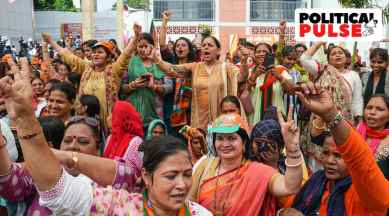Women’s quota Bill and two-member constituencies: Abolished in 1961, will such seats make a return?
With the rotational policy of reserving seats for women drawing some criticism, one suggestion is to convert some of the constituencies to double-member seats to ensure women’s representation in Parliament goes up without affecting existing MPs and their constituencies. But can it work?

The women’s reservation Bill was cleared by Parliament this week, but questions remain about when and how it will be implemented. Aside from the provision that makes the Bill’s implementation contingent upon the next Census and delimitation exercise, the proposed rotational basis of assigning the seats to be reserved for women has drawn some criticism.
Rotation of reserved seats, PRS Legislative Research notes in its analysis of the 2023 Bill, “may reduce the incentive for MPs to work for their constituencies as they could be ineligible to seek re-election from that constituency”. A Ministry of Panchayati Raj study on rotating seats in panchayats found that only 15% of sitting women members got re-elected, in part due to some of the winners’ seats getting de-reserved in the following election. Male MPs have opposed rotational reservation in the past because of the uncertainty around which specific seats may be reserved, potentially putting their political careers at risk.
In the Lok Sabha, if a third of the 543 Lok Sabha constituencies are converted to dual-member seats, there will be 181 women MPs with the total number of MPs increasing to 724. But in this case, the effective share of women MPs in the House will be 25%. Assuming the total number of Lok Sabha seats remains unchanged at 543, to maintain 33% reservation for women in terms of the number of members, half of all constituencies would have to be converted to dual membership. It will add at least 272 women MPs to the Lok Sabha and raise the strength of the House to 815 MPs. One of the advantages of keeping the total number of constituencies at 543, instead of simply adding new seats reserved for women, is that reservation can be implemented without a fresh delimitation exercise. Increasing the Lok Sabha strength will only require a constitutional amendment. Incidentally, the new Parliament building can seat 888 members in the Lower House.
Unlike in the rotational system, dual-member constituencies won’t limit the voters’ choice of candidates while also improving the population-to-MP ratio for such seats. Currently, each Lok Sabha MP represents an average of 25 lakh people.
In 2008, the Jayanti Natarajan-headed Standing Committee on Law and Justice, which assessed the UPA government’s reservation Bill, said that “double-member constituencies might result in women being reduced to a subservient status”.
Why dual-member constituencies were abolished
Dual-member constituencies were introduced by the Delimitation Commission Act, 1952, to reserve seats with sizeable SC and ST populations. Seats with more than half the population belonging to SCs or STs were single-member constituencies. But after the first two Lok Sabha elections, in 1952 and 1957, the system was discarded through the Two-Member Constituencies (Abolition) Act, 1961.
In the 1952 Lok Sabha polls, there were a total of 86 two-member seats. Uttar Pradesh had the most at 17 out of a total of 69 while Madhya Pradesh and the erstwhile Vindhya Pradesh had the highest share of such seats at 50%. West Bengal had the only three-member seat with one MP each for the general, SC, and ST categories. In 1957, there were 91 two-member seats — UP had the highest number at 18 and Odisha had the highest share at 50%. There were also 579 two-member Assembly seats (and one three-member seat in the erstwhile Bombay state) in 1951 and 551 in 1957.
Dual-membership faced major criticism after the 1957 election as 20 such constituencies saw winners from the same group, either SC or ST, and did not elect a general candidate. After ST candidates won the reserved and unreserved positions in the two-member constituency of Parvathipuram, Andhra Pradesh, then Uttar Pradesh Governor V V Giri, later the President of India, moved the Supreme Court challenging the result on constitutional and legal grounds. A five-judge bench, however, upheld the result saying that “it was open to the ST candidates to contest not only the reserved seat but also the general seat” as per the Representation of the People Act.
A drawback of these constituencies was that they were larger than regular seats and required more resources to administer and campaign. A report the Election Commission published after the 1962 Lok Sabha polls noted that “members of SCs and STs generally favour small single-member constituencies, which involve less expenditure and trouble”. Some SC and ST members also said they would hold a more prominent position in a single-member constituency.
Under the paper ballot system, there was also nothing stopping voters from voting for the same candidate with both their ballots. Though it still counted as one vote, it gave returning officers the arduous task of “scrutinising the serial number of every single ballot paper in every ballot box and rejecting one ballot paper whenever two with the same serial number, one with the suffix A and the other with the suffix B, were found in one ballot box”.